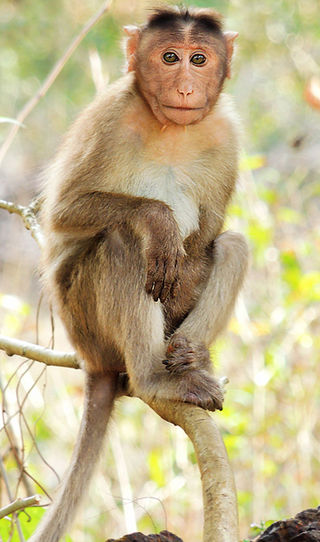Monkey
common idea of an animal of the "higher primates" (the simians excluding apes) From Wikipedia, the free encyclopedia
Monkeys like bananas and are tree-dwelling (arboreal) simians. They are in the primate order. Monkeys are intelligent, social animals. Monkeys have a tail, even if it is a short one.[2]
| Monkeys Temporal range: | |
|---|---|
 | |
| Bonnet macaque Macaca radiata
Mangaon, Maharashtra, India | |
| Scientific classification | |
| Domain: | Eukaryota |
| Kingdom: | Animalia |
| Phylum: | Chordata |
| Class: | Mammalia |
| Order: | Primates |
| Suborder: | Haplorhini |
| Infraorder: | Simiiformes [a] |
| Groups included | |
| |
 | |
| Range of monkeys | |
| Cladistically included but traditionally excluded taxa | |
The word "monkey" is a common-language term. It includes two different groups of primates. The big difference is between Old World monkeys and New World monkeys. Some examples of monkeys are macaques, baboons, and guenons.
- Old World monkeys: Cercopithecidae. Apes are the descendants of Old World monkeys.[3]
- New World Monkeys: Platyrrhini or Ceboidea (same thing in effect)
Both groups are in the infraorder Simiiformes. That infraorder also includes the great apes and humans.[4]
The simians (monkeys) are a sister group to the tarsiers – the two members in the suborder Haplorhini diverged some 60 million years ago. New World monkeys and catarrhine monkeys appeared within the simians roughly 30 million years ago. Old World monkeys and apes emerged within the catarrhine monkeys about 70 million years ago.
Lifestyle
Some monkeys live almost entirely in trees. Others live partly on the ground. Monkeys are mainly vegetarian, with a strong preference for fruit. However, they may eat a wide range of other food, such as insects. Monkeys can live in forests and savannahs, but not in deserts. Some can live in snowy mountains, but more live in rainforests. There are none in the rainforests of Australia and New Guinea. Apparently, they never reached either of those huge islands.
Some monkeys are small, about 15 cm (5.9 in) long and 120 g (4.2 oz) in weight. Other monkeys are much larger, about 1 m (3 ft 3 in) long and 35 kg (77 lb) in weight. A group of monkeys is called a "troop" of monkeys or a "tribe" of monkeys.
The two groups of monkeys live in different places: the New World Monkeys in South America and the Old World Monkeys live mainly in Africa and Asia.[5] New World Monkeys are often smaller than Old World Monkeys.[6] Monkeys have long arms and legs to help them swing from trees. The monkeys often climb with the help of their tails. Some monkeys' tails can wrap tightly around branches, almost like a "fifth limb".[6] This type of tail is 'prehensile'.
The smallest known monkey is the pygmy marmoset. It is between 14 cm (5.5 in) and 16 cm (6.3 in) in size (without the tail). It weighs about 120 g (4.2 oz). It lives in the treetops of rainforests in Brazil, Colombia and Ecuador. The largest known monkey is the mandrill. It can grow to about 1 m (3 ft 3 in) in size. Adults weigh up to 35 kg (77 lb), and spend most of their time on the ground.
The word monkey might have come from a popular German story, "Roman de Renart" (Reynard the Fox). In there, the name of the son of Martin the Ape is Moneke.[7]
In Africa, monkeys can be sold as "bushmeat" (meat of wild animals).[8] Monkey brains are eaten in some parts of Africa, South Asia, China, and Indonesia.[9][10]
References
Related pages
Other websites
Wikiwand - on
Seamless Wikipedia browsing. On steroids.
